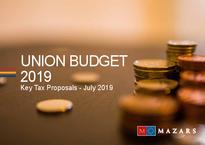Union Budget 2019 | Key Tax Proposals
Whilst there was no change in personal income tax rates to the public interest, a slew of interest expense deductions on dedicated loans and lower cost of capital should boost monetary morale for a significant part of the population. Concurrently, the push towards liberal institutionalized reforms that build in a robust capital market can eventually seep in to make the economic pie larger for all. It all rests upon timely implementing the plate full of reforms that has been pieced together for the next five years.
Technology stands at the fulcrum, as a series of measures undertake to increase interoperability and accessibility across the value chain, automizing tasks and reducing human error & intervention. These include facilitating electronic information-sharing across banks & companies that aid taxpayers with pre-filled tax returns, cutting out non-transparent human interfaces during the assessment process, forwarding the use of low-cost digital payment mechanisms by customers & merchants, alongside fostering a conducive intellectual environment that creates digital literacy. New-age themes such as artificial intelligence, robotics, and IoT are here to grow.
The impetus on technological advancement is closely linked to address large-scale Infrastructural development, lying at the heart of the budgetary focus. Programs such as Bharatmala, Dedicated Freight Corridors, Sagarmala and UDAN will continue to increase connectivity and competitiveness in the domestic market, with newer mediums such as rivers being utilized to decongest current routes. The government has also projected the necessity of public private partnerships across capital-intensive sectors such as railways that require over INR 50 lakh crore from 2018 to 2030, in order to unleash faster development and get modernization projects off the ground.
Both rural and urban India received their own share of the limelight as the budget looked at creating conducive living conditions across localities. Schemes such as the Pradhan Mantri Gram Sadak Yojana have received an investment target of INR 80,250 crore to build 125,000km of village roads. Meanwhile, electricity & LPG connections are to be extended to all willing rural families by 2022 while water facilities are to be brought about by 2024. Concurrently, a re-shift to zero-budget farming is proposed to double farmers’ incomes whilst a productivity boost in home development will keep the affordable housing goal up & running. Rapid urbanization on the other side of the spectrum is seen as an opportunity than a challenge, with improvements in suburban & long-distance travel, attractive home & auto loans, start-up schemes and impartment of soft skills to set in a new ease of living.
Small businesses and MSMEs emerged at the focal, as the government proposed to extend pension benefit to 3 crore retail traders (having an annual turnover of less than INR 1.5 crore) under the Pradhan Mantri Karam Yogi Man Dan Scheme. Initiatives such as creating a friendly payment platform for smaller businesses, extending the annual turnover threshold for reduced corporate taxation from INR 250 crore to INR 400 crore, alongside creating hundred new clusters that bring over 50,000 artisans into the economic value chain, can act as inherent catalysts for smaller players.
Having said this, whilst there was no change in personal income tax rates to the public interest, a slew of interest expense deductions on dedicated loans and lower cost of capital should boost monetary morale for a significant part of the population. At the same time, the push for liberal institutionalized reforms that encourage investment from individuals such as NRIs as well as foreign bodies can make India into a strengthened hub for global financial activities. This can eventually drill down into creating new monetary opportunities and better returns. It all rests upon timely implementing the plate full of reforms that has been pieced together for the next five years.

